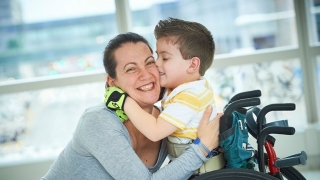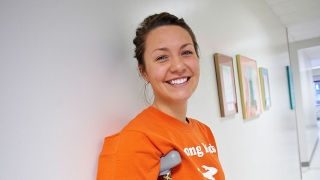Slipped Capital Femoral Epiphysis
What is slipped capital femoral epiphysis?
Slipped capital femoral epiphysis (SCFE) is a condition of the hip joint that affects adolescents. In SCFE, the head, or "ball," of the thigh bone (referred to as the femoral head) slips off the neck of the thigh bone. An analogy commonly used to describe this condition is that it can be like a scoop of ice cream slipping off the top of a cone. This condition causes the hip joint to become painful and stiff.
Approximately one-half of SCFE cases affect both hips, and boys are affected more often than girls. Symptoms may start abruptly (acute slip) or occur over an extended period of time (chronic slip). SCFE develops most often during short periods of accelerated growth following the onset of puberty.
SCFEs can be divided into two major types:
- Stable: In this type of SCFE, adolescents are still able to put weight on the affected leg with or without crutches. While the pain is significant, it isn’t too severe but can build over time. Because the SCFE or “slip” is happening slowly, the blood flow to the hip is not affected. Over 90 percent of SCFEs fall into this category.
- Unstable: In this type of SCFE, the pain occurs suddenly, almost like a break. Pain is usually severe and patients can’t walk, not even with crutches. Because this type of SCFE occurs suddenly, the blood flow can be affected 20 to 50 percent of the time which can result in the bone dying (avascular necrosis). Less than 10 percent of SCFEs fall into this category.
Causes
The cause of SCFE is unknown. Risk factors that increase the likelihood of SCFE include the following:
Risk factors may include:
- Obesity
- Medications (such as steroids)
- Thyroid problems
- Radiation treatment
- Bone problems related to kidney disease
Who is affected?
SCFE is a condition which is more likely to occur in boys than girls. Children ages 10 to 16 years are most at risk.
SCFE is more prevalent in the northeast region of the United States than in the southwestern states. It is also more prevalent among African-Americans. In many cases, the child is overweight.
Signs and symptoms
Symptoms of SCFE typically include complaints of pain in the groin or hip that is aggravated by activity. Sometimes the child will also experience pain in the thigh or knee area.
In acute or unstable slips, the child will complain of immediate pain, limp, or feel like the leg is "giving way."
The child with a chronic or stable slip usually walks with a limp, complains of hip pain, and reports that rest alleviates the pain. The child may also walk with his or her leg turned outward. As the slip progresses, the shape of the hip changes and it becomes stiffer and harder to bend and rotate the hip.
The symptoms of SCFE may resemble other conditions or medical problems of the hip. Always consult your child's doctor for a diagnosis.
Testing and diagnosis
In addition to a complete medical history and physical examination, diagnostic procedures for SCFE almost always include X-rays, which use invisible electromagnetic energy beams to produce images of the bone onto film.
The ultimate goal in SCFE is to diagnose the condition early in order to prevent the head of the femur from slipping further off of the thigh bone, thus preventing hip deformity. For patients who present with more severe slips, the goal may be to maximize range of motion and preserve long term function of the hip joint.
When the diagnosis of SCFE is initially made, the child is not allowed to bear weight on the hip (crutches or a wheelchair may be used) and most patients are admitted directly to the hospital for further treatment.
Treatment
Specific treatment for SCFE will be determined by your child's doctor based on:
- Your child's age, overall health, and medical history
- The extent of the condition
- Expectations for the course of the condition
- Your opinion or preference
The goal of treatment is to prevent the femoral head from further slippage, preserve motion in the hip, and to minimize complications. Treatment of a SCFE generally requires surgery otherwise the slip will continue to get worse and worse. The type of surgery recommended will depend on the individual patient, and the severity of the SCFE, but almost always includes placement of at least one screw into the hip to prevent the ball from sliding any further.
Consequences of SCFE as a young adult
Many patients who are initially well-treated for a SCFE may develop more pain and symptoms as older teenagers and young adults. This usually occurs from the residual shape of the hip after the hip has fully healed. CHOP’s Young Adult Hip Preservation Program specializes in the management of these patients. In many cases, symptoms can be alleviated and function improved by physical therapy, selective injections and/or specialized hip preservation surgeries.
Long-term outlook
The more severe the case, the greater the likelihood the child will experience limited hip motion, differences in leg lengths, and further hip problems in adulthood. However, with early detection and proper treatment, a good outcome with few problems is possible.
Reviewed by Wudbhav N. Sankar, MD




